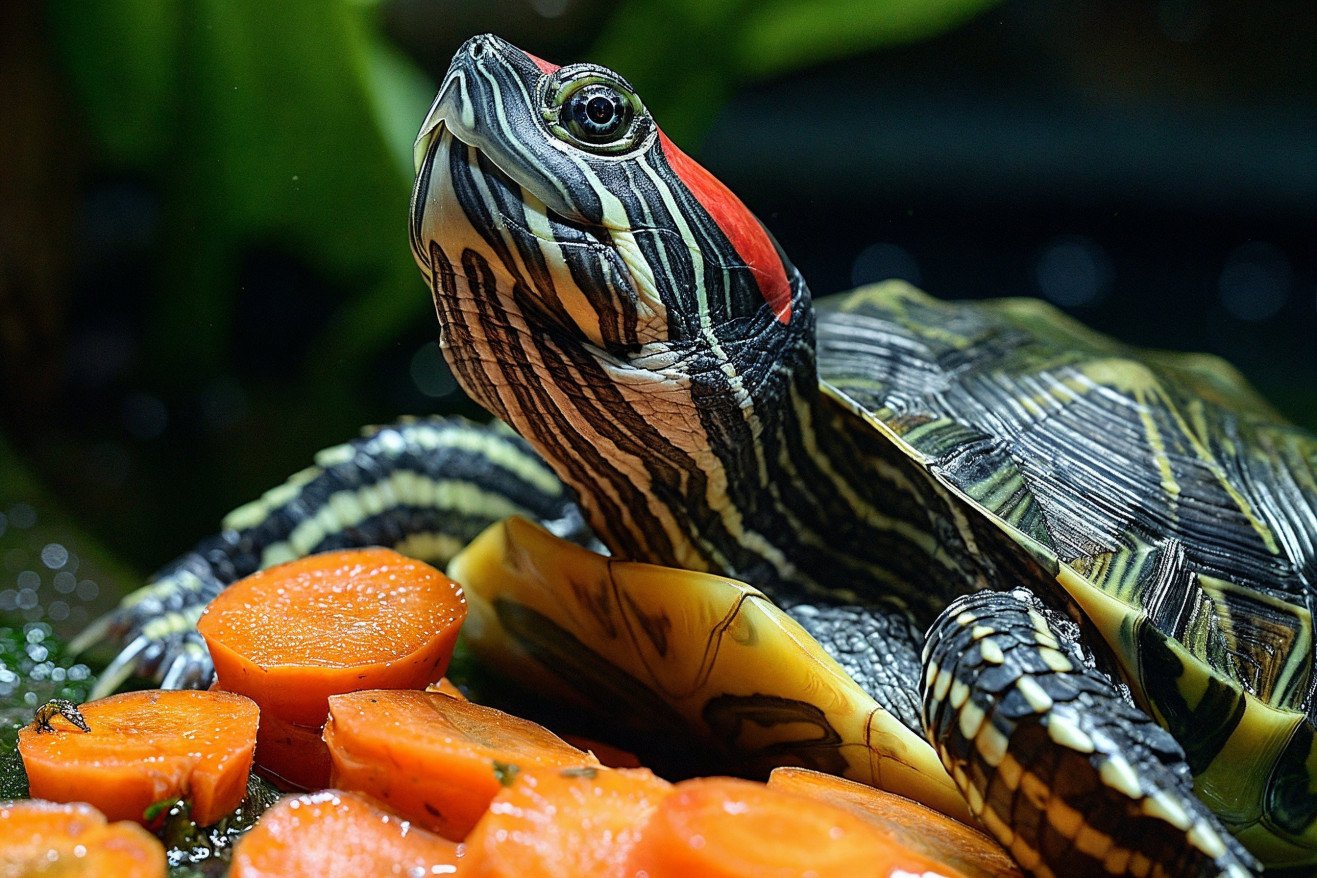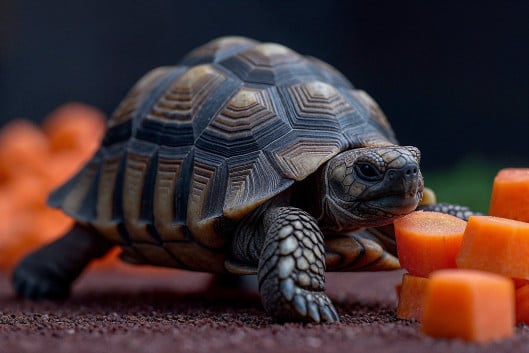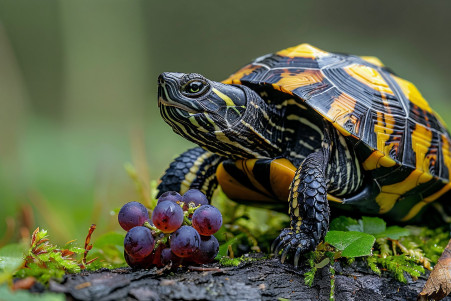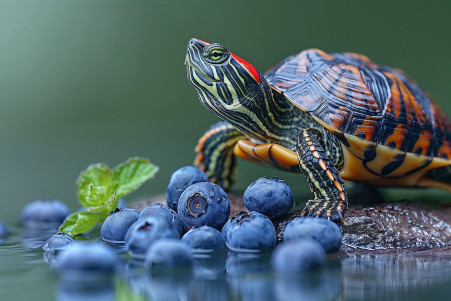Can Turtles Have Carrots? Here's What You Need to Know
23 March 2024 • Updated 22 March 2024

You know that carrots are a good snack for rabbits, but you may be wondering if they're also a good option for your pet turtle. The truth is that turtles can eat carrots as part of a well-rounded diet, but they should be fed in moderation because they're high in sugar and low in other nutrients that turtles need.
Although carrots don't have everything that turtles need, our investigation covers the nutritional benefits and concerns of feeding turtles carrots in the right way. We summarize the research on the nutritional content of carrots and review the recommendations of experts to determine the best way to feed carrots to turtles. This will help you understand the right amount of carrots to feed your turtle and learn some fun ways to give them to your pet as an occasional treat.
Can turtles eat carrots?
Nutritional Value of Carrots for Turtles
Carrots do have some nutritional value for turtles, but there are also some potential downsides that make them less than ideal as a regular part of a turtle's diet. On the plus side, carrots are a good source of vitamin A, which is important for a turtle's eyesight, growth, and immune system, notes WebMD. They also contain fiber, potassium, and some calcium.
On the downside, carrots are low in protein and other nutrients turtles need to be healthy. In addition, their sugar content is relatively high and can lead to obesity and other health problems if turtles eat too many. However, the biggest downside of carrots is that they are high in oxalates, which can bind to calcium and prevent it from being absorbed by the body, potentially leading to a calcium deficiency, explains research cited by Hepper.
While carrots do offer some vitamin A and fiber, they aren't the best source of nutrition for turtles. As a result, they should be used as a supplement, not a staple, in a turtle's diet since the cons of feeding them to turtles in large amounts outweigh the pros. As a result, it's important to use caution and feed your turtle carrots in moderation as part of a varied, well-rounded diet.
Types of Turtles and Eating Carrots
Most popular pet turtle species, such as red-eared sliders, box turtles, and painted turtles, can eat carrots in moderation. The Spruce Pets explains that carrots are a suitable food for red-eared slider turtles and can even be shredded to make them easier for smaller turtles to eat.
Since aquatic turtles like red-eared sliders are more likely to eat carrots, they may get more of the benefits of the fiber in carrots than land-dwelling turtles like box turtles. However, Box Turtle World points out that box turtles in captivity can eat shredded carrots too.
It's possible that younger turtles have different dietary needs, and Pet Keen suggests checking with a vet before giving carrots or any other new food to a turtle. Turtles with certain health issues or dietary needs may have to eat fewer carrots or avoid them altogether. The turtle species' overall diet and eating patterns should be taken into account when deciding how much of a turtle's diet should consist of carrots.
How to Add Carrots to a Healthy Turtle Diet
Carrots should only be given to turtles as an occasional treat or supplement, not as a staple food. Per WikiHow, the general portion size for adult turtles is usually about the size of their head and neck, which typically equates to a few slices or a small handful. Juvenile turtles may need to be fed smaller portions more frequently.
Whole, shredded, or mixed with other vegetables are all ways to give carrots to turtles to ensure they get a variety of nutrients. Box Turtle World suggests shredding carrots before giving them to turtles to make them easier to eat. However, carrots and other vegetables that are high in nutrients should only make up a small portion of a turtle's vegetable intake, with leafy greens, squash, and bell peppers being the main part of their diet.
In addition to vegetables, Pets on Mom.com says that animal-based proteins, including insects, fish, and turtle pellets, are also important parts of a turtle's diet. By making sure to include a variety of healthy foods, you can make sure that your turtle gets all the nutrients that it needs to be healthy.
Other Healthy Vegetable Options for Turtles
While carrots are a great option, there are other healthy vegetables that turtles can eat. WebMD recommends leafy greens like collard greens, dandelion greens, and mustard greens, which are all packed with vitamins and minerals. Other vegetables that are good for turtles include bell peppers, green beans, sweet potatoes, and squash.
Berries, apples, and melons are also good options for turtles, but they should be fed in moderation and used as a treat or a way to help turtles stay hydrated. For aquatic turtles, WebMD says that it's important to feed them aquatic plants like water hyacinth and duckweed.
That said, there are some vegetables, such as spinach and rhubarb, that turtles should eat in moderation or avoid because they contain oxalates, which Hepper explains can interfere with calcium absorption. That said, if you feed your turtle a variety of healthy, plant-based foods, you can be sure that they're getting the nutrients they need to stay healthy.
How Often and How Much Should You Feed a Pet Turtle?
Juvenile turtles should be fed every day, while adult turtles can be fed every 2-3 days, says Pets on Mom.com. The food portion should be about the size of the turtle's head and neck, which is recommended by WikiHow since they say that you should feed turtles an amount of food that would fit in their head and neck.
Aquatic turtles should be fed in the water to avoid the food that's left over from rotting in the tank, according to WikiHow. Meanwhile, adult turtles may need to be fed less often during periods of inactivity or hibernation, since Pets on Mom.com notes that box turtles can go into dormancy between the fall and spring.
Portion control is important since overfeeding can lead to obesity and other health problems. In fact, Pets on Mom.com says that turtles should be fed only as much as they can eat in 5-15 minutes, and any food that's left over should be taken out of their environment.
Things Not to Feed Your Turtle
There are certain plants and foods that are dangerous for turtles to consume. Some of these, like rhubarb, tobacco leaves, tomato leaves, and potato leaves, are listed by Box Turtle World as toxic and should never be given to turtles. Avocado skins and pits are also toxic and should not be part of a turtle's diet.
In addition to toxic plants, dairy products, processed foods, and sugary non-food items should not be given to turtles because they can't be digested. According to Box Turtle World, these items can cause health problems. Frozen or freeze-dried fish, earthworms, and insects from the yard can also contain bacteria or parasites that are harmful to turtles, so they should be avoided.
Raw chicken or beef can also be problematic and should not be part of a turtle's regular diet, according to the experts. Knowing what not to feed your turtle can help you make sure that you're providing them with a safe and healthy diet.
Conclusion: How to Make a Healthy, Balanced Diet for Your Turtle
Carrots can be a healthy and occasional treat for most pet turtles as long as they are fed in moderation as part of a balanced diet. The majority of a turtle's diet should be made up of a variety of nutrient-dense vegetables, fruits, and animal-based proteins. Portion control and feeding frequency are important to prevent obesity and other health problems.
VCA Animal Hospitals recommends that box turtles eat a diet that is 50% plant-based and 50% animal-based. Suitable vegetables that should be a large part of the box turtle's diet include collard greens, beet greens, mustard greens, broccoli, and more. Fruits should be a smaller part of the diet since box turtles often prefer them to vegetables and they are less nutritious.
Painted turtles should eat a diet that is heavy in vegetables, leafy greens, and flowers. Box turtles should eat a diet that is heavy in dark leafy greens and fruits, while aquatic turtles should eat a diet that is heavy in vegetables and fruits.
No matter what type of turtle you have, it's important to talk to a vet to get a diet that is specific to your turtle's age, species, and individual needs. By learning about the nutritional needs and safe foods, you can make sure that your turtle is getting everything it needs to live a long and healthy life.


